Solar System: 10 Ways Interns Are Exploring Space With Us
Solar System: 10 Ways Interns Are Exploring Space With Us
Simulating alien worlds, designing spacecraft with origami and using tiny fossils to understand the lives of ancient organisms are all in a day’s work for interns at NASA.
Here’s how interns are taking our missions and science farther.
1. Connecting Satellites in Space

Becca Foust looks as if she’s literally in space – or, at least, on a sci-fi movie set. She’s surrounded by black, except for the brilliant white comet model suspended behind her. Beneath the socks she donned just for this purpose, the black floor reflects the scene like perfectly still water across a lake as she describes what happens here: “We have five spacecraft simulators that ‘fly’ in a specially designed flat-floor facility,” she says. “The spacecraft simulators use air bearings to lift the robots off the floor, kind of like a reverse air hockey table. The top part of the spacecraft simulators can move up and down and rotate all around in a similar way to real satellites.” It’s here, in this test bed on the Caltech campus, that Foust is testing an algorithm she’s developing to autonomously assemble and disassemble satellites in space. “I like to call it space K’nex, like the toys. We’re using a bunch of component satellites and trying to figure out how to bring all of the pieces together and make them fit together in orbit,” she says. A NASA Space Technology Research Fellow, who splits her time between Caltech and NASA’s Jet Propulsion Laboratory (JPL), working with Soon-Jo Chung and Fred Hadaegh, respectively, Foust is currently earning her Ph.D. at the University of Illinois at Urbana-Champaign. She says of her fellowship, “I hope my research leads to smarter, more efficient satellite systems for in-space construction and assembly.”
2. Diving Deep on the Science of Alien Oceans

Three years ago, math and science were just subjects Kathy Vega taught her students as part of Teach for America. Vega, whose family emigrated from El Salvador, was the first in her family to go to college. She had always been interested in space and even dreamed about being an astronaut one day, but earned a degree in political science so she could get involved in issues affecting her community. But between teaching and encouraging her family to go into science, It was only a matter of time before she realized just how much she wanted to be in the STEM world herself. Now an intern at NASA JPL and in the middle of earning a second degree, this time in engineering physics, Vega is working on an experiment that will help scientists search for life beyond Earth.
“My project is setting up an experiment to simulate possible ocean compositions that would exist on other worlds,” says Vega. Jupiter’s moon Europa and Saturn’s moon Enceladus, for example, are key targets in the search for life beyond Earth because they show evidence of global oceans and geologic activity. Those factors could allow life to thrive. JPL is already building a spacecraft designed to orbit Europa and planning for another to land on the icy moon’s surface. “Eventually, [this experiment] will help us prepare for the development of landers to go to Europa, Enceladus and another one of Saturn’s moons, Titan, to collect seismic measurements that we can compare to our simulated ones,” says Vega. “I feel as though I’m laying the foundation for these missions.”
3. Unfolding Views on Planets Beyond Our Solar System

“Origami is going to space now? This is amazing!” Chris Esquer-Rosas had been folding – and unfolding – origami since the fourth grade, carefully measuring the intricate patterns and angles produced by the folds and then creating new forms from what he’d learned. “Origami involves a lot of math. A lot of people don’t realize that. But what actually goes into it is lots of geometric shapes and angles that you have to account for,” says Esquer-Rosas. Until three years ago, the computer engineering student at San Bernardino College had no idea that his origami hobby would turn into an internship opportunity at NASA JPL. That is, until his long-time friend, fellow origami artist and JPL intern Robert Salazar connected him with the Starshade project. Starshade has been proposed as a way to suppress starlight that would otherwise drown out the light from planets outside our solar system so we can characterize them and even find out if they’re likely to support life. Making that happen requires some heavy origami – unfurling a precisely-designed, sunflower-shaped structure the size of a baseball diamond from a package about half the size of a pitcher’s mound. It’s Esquer-Rosas’ project this summer to make sure Starshade’s “petals” unfurl without a hitch. Says Esquer-Rosas, “[The interns] are on the front lines of testing out the hardware and making sure everything works. I feel as though we’re contributing a lot to how this thing is eventually going to deploy in space.”
4. Making Leaps in Extreme Robotics

Wheeled rovers may be the norm on Mars, but Sawyer Elliott thinks a different kind of rolling robot could be the Red Planet explorer of the future. This is Elliott’s second year as a fellow at NASA JPL, researching the use of a cube-shaped robot for maneuvering around extreme environments, like rocky slopes on Mars or places with very little gravity, like asteroids. A graduate student in aerospace engineering at Cornell University, Elliott spent his last stint at JPL developing and testing the feasibility of such a rover. “I started off working solely on the rover and looking at can we make this work in a real-world environment with actual gravity,” says Elliott. “It turns out we could.” So this summer, he’s been improving the controls that get it rolling or even hopping on command. In the future, Elliott hopes to keep his research rolling along as a fellow at JPL or another NASA center. “I’m only getting more and more interested as I go, so I guess that’s a good sign,” he says.
5. Starting from the Ground Up

Before the countdown to launch or the assembling of parts or the gathering of mission scientists and engineers, there are people like Joshua Gaston who are helping turn what’s little more than an idea into something more. As an intern with NASA JPL’s project formulation team, Gaston is helping pave the way for a mission concept that aims to send dozens of tiny satellites, called CubeSats, beyond Earth’s gravity to other bodies in the solar system. “This is sort of like step one,” says Gaston. “We have this idea and we need to figure out how to make it happen.” Gaston’s role is to analyze whether various CubeSat models can be outfitted with the needed science instruments and still make weight. Mass is an important consideration in mission planning because it affects everything from the cost to the launch vehicle to the ability to launch at all. Gaston, an aerospace engineering student at Tuskegee University, says of his project, “It seems like a small role, but at the same time, it’s kind of big. If you don’t know where things are going to go on your spacecraft or you don’t know how the spacecraft is going to look, it’s hard to even get the proposal selected.”
6. Finding Life on the Rocks

By putting tiny samples of fossils barely visible to the human eye through a chemical process, a team of NASA JPL scientists is revealing details about organisms that left their mark on Earth billions of years ago. Now, they have set their sights on studying the first samples returned from Mars in the future. But searching for signatures of life in such a rare and limited resource means the team will have to get the most science they can out of the smallest sample possible. That’s where Amanda Allen, an intern working with the team in JPL’s Astrobiogeochemistry, or abcLab, comes in. “Using the current, state-of-the-art method, you need a sample that’s 10 times larger than we’re aiming for,” says Allen, an Earth science undergraduate at the University of California, San Diego, who is doing her fifth internship at JPL. “I’m trying to get a different method to work.” Allen, who was involved in theater and costume design before deciding to pursue Earth science, says her “superpower” has always been her ability to find things. “If there’s something cool to find on Mars related to astrobiology, I think I can help with that,” she says.
7. Taking Space Flight Farther

If everything goes as planned and a thruster like the one Camille V. Yoke is working on eventually helps send astronauts to Mars, she’ll probably be first in line to play the Mark Watney role. “I’m a fan of the Mark Watney style of life [in “The Martian”], where you’re stranded on a planet somewhere and the only thing between you and death is your own ability to work through problems and engineer things on a shoestring,” says Yoke. A physics major at the University of South Carolina, Yoke is interning with a team that’s developing a next-generation electric thruster designed to accelerate spacecraft more efficiently through the solar system. “Today there was a brief period in which I knew something that nobody else on the planet knew – for 20 minutes before I went and told my boss,” says Yoke. “You feel like you’re contributing when you know that you have discovered something new.”
8. Searching for Life Beyond Our Solar System

Without the option to travel thousands or even tens of light-years from Earth in a single lifetime, scientists hoping to discover signs of life on planets outside our solar system, called exoplanets, are instead creating their own right here on Earth. This is Tre’Shunda James’ second summer simulating alien worlds as an intern at NASA JPL. Using an algorithm developed by her mentor, Renyu Hu, James makes small changes to the atmospheric makeup of theoretical worlds and analyzes whether the combination creates a habitable environment. “This model is a theoretical basis that we can apply to many exoplanets that are discovered,” says James, a chemistry and physics major at Occidental College in Los Angeles. “In that way, it’s really pushing the field forward in terms of finding out if life could exist on these planets.” James, who recently became a first-time co-author on a scientific paper about the team’s findings, says she feels as though she’s contributing to furthering the search for life beyond Earth while also bringing diversity to her field. “I feel like just being here, exploring this field, is pushing the boundaries, and I’m excited about that.”
9. Spinning Up a Mars Helicopter

Chloeleen Mena’s role on the Mars Helicopter project may be small, but so is the helicopter designed to make the first flight on the Red Planet. Mena, an electrical engineering student at Embry-Riddle Aeronautical University, started her NASA JPL internship just days after NASA announced that the helicopter, which had been in development at JPL for nearly five years, would be going to the Red Planet aboard the Mars 2020 rover. This summer, Mena is helping test a part needed to deploy the helicopter from the rover once it lands on Mars, as well as writing procedures for future tests. “Even though my tasks are relatively small, it’s part of a bigger whole,” she says.
10. Preparing to See the Unseen on Jupiter’s Moon Europa

In the 2020s, we’re planning to send a spacecraft to the next frontier in the search for life beyond Earth: Jupiter’s moon Europa. Swathed in ice that’s intersected by deep reddish gashes, Europa has unveiled intriguing clues about what might lie beneath its surface – including a global ocean that could be hospitable to life. Knowing for sure hinges on a radar instrument that will fly aboard the Europa Clipper orbiter to peer below the ice with a sort of X-ray vision and scout locations to set down a potential future lander. To make sure everything works as planned, NASA JPL intern Zachary Luppen is creating software to test key components of the radar instrument. “Whatever we need to do to make sure it operates perfectly during the mission,” says Luppen. In addition to helping things run smoothly, the astronomy and physics major says he hopes to play a role in answering one of humanity’s biggest questions. “Contributing to the mission is great in itself,” says Luppen. “But also just trying to make as many people aware as possible that this science is going on, that it’s worth doing and worth finding out, especially if we were to eventually find life on Europa. That changes humanity forever!”
Read the full web version of this week’s ‘Solar System: 10 Things to Know” article HERE.
Make sure to follow us on Tumblr for your regular dose of space: http://nasa.tumblr.com.
More Posts from Nofiafitri and Others

“University presses don’t just publish books: they keep books in print and rescue out-of-print books from obscurity … But the digital age complicates and threatens the mission of the country’s approximately 100 university presses. Ellen Faran, director of MIT Press, recently told Harvard Magazine: ‘I like doing things that are impossible, and there’s nothing more impossible than university-press publishing.’”
For more of this morning’s roundup, click here.

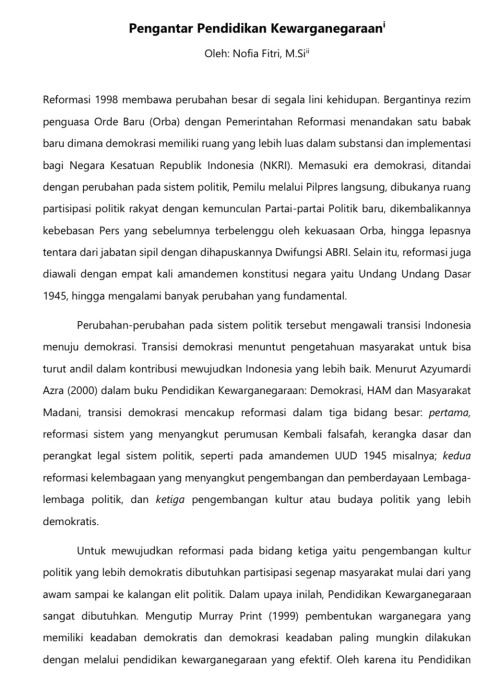

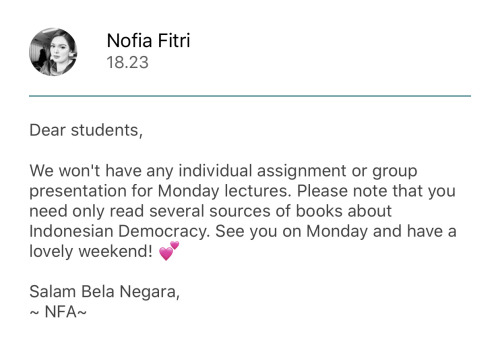
Wonderful!




#1 Get Comfortable
Nothing distracts you more than uncomfortable clothes! So wear all the things you are feeling completely comfy in and put your hair of the way. Personally, I like to wear simple shirts and yoga pants or leggings, also I put my hair up in a bun. And: forget the bra, girl! You are just sitting in front of your desk, no one cares. You should also make sure that, especially in winter, your feet won’t get cold. So: some cozy socks are needed!
#2 Tidy Up
I just can’t concetrate when my room is a mess, so normally I’ll tidy my complete room before I start my study session. This will help you so you don’t get easily distracted when you study and you’ll have more space to spread your notes around.
#3 Set Up Your Study Space
You don’t want to interrupt your studying because you have to get something you need, do you? So make sure you have everything you need before you start. And don’t forget to stay hydrated! So always have a bottle of water by hand, it will increase your productivity and help you to stay concentrated!
HOW TO WRITE A STRONG ESSAY
I recently got an ask about how to write an introductory paragraph for an essay so I thought I’d do a post about how to write a good essay.
** Important Points ** For essays in high school, use third person unless the teacher specifically tells you not too. It’s more academic and professional while first person sounds really informal. I’ve heard that in college it’s different but again, it depends on the class. Stay on the safe side and use third person unless otherwise specified. Also, try to be as sophisticated and mature as you can. This makes the essay sound smarter and makes it easier to read.
1) INTRODUCTION
Try to think of an upside down pyramid here. You start off broad and end off tapered to a point (specific). The formula for writing a good intro is this: hook, background info, introduce topic of discussion, and thesis. In the pyramid example, the hook is the broad and the thesis is the narrow. The intro is usually around 8 sentences long.
Hook: Unlike what you’ve probably been told through out high school, the hook is not necessarily a wow statement. It’s typically a broad idea that relates to the topic of discussion. I usually use historical facts or common wisdom and go from there. I then follow it up with a sentence that elaborates on my hook and a sentence that connects my hook with the background info.
Background Info: Here you give the reader some context as to what you will be discussing in your essay. It sets the scene for the topic you’re discussing. Try to be concise.
Introduce the Topic of Discussion: Here you give a brief summary of the points you’re arguing/discussing. It should be one sentence per body paragraph and again, be clear and concise and avoid merely summarizing the plot. This part should cover the gist of your ideas.
Thesis: This should be a longer complex sentence that summarizes your point of view and ideas. This is one of the most important parts of the essay so crafting a good thesis is crucial.
I did a more detailed post about the introduction with an example introduction paragraph HERE.
2) BODY PARAGRAPHS
The meat of your essay. Here is where you state your arguments and defend them with supporting evidence from literature, articles, or even your personal experience. I would generally limit one argument per body paragraph. Which reminds me, most likely you have been taught the canned five paragraph essay. Some people write all their essays in five paragraph format because they thing that is the only way to go. Really, you can do four+ body paragraphs with the common numbers being four and six. It depends on the essay. When writing your body paragraph you need this structure: topic sentence, three points, three examples of supporting evidence, conclusion. Body paragraphs typically fall between 8 -15 sentences.
Topic Sentence: This is similar to a thesis. Here you’re stating the argument that you are proving in a clear and concise sentence.
Three Points: There’s a rule of thumb that you generally want to have three points about each argument and have a piece of supporting evidence for each point. I’m going to start with the three points first. Basically, you want three ideas about your argument that show why it’s valid. For example if you’re trying to argue that cheese is dairy, your three points are it’s made of milk, it’s featured in the dairy section of the grocery store, and the FDA labels it as dairy.
Three Examples of Supporting Evidence: These are usually quotes from other sources or the piece of literature you’re analyzing that support the three points of your argument. To use the really bad cheese example from above, for the milk point you’d use an ingredients label from a package of cheese, for the grocery store point you’d get a sheet with the department labels and the produce in those departments, and for the FDA point you’d find a quote from their website.
Conclusion: This is a sentence or two that wraps up your body paragraph. It should briefly summarize the points you discussed or the topic sentence and help transition into the next paragraph.
2) a. COUNTER ARGUMENT PARAGRAPHS
This paragraph is NOT necessary for most essays. However, some do require them so it’s important to know how to approach them. Depending on whom you ask, they’ll either tell you that the counter argument paragraph goes in the middle of your body paragraphs, or at the end. Personally I prefer the end but the middle is more correct. Placing it in the middle allows you to end on a strong note but I think it’s a matter of personal preference. The counter argument is used to present an opposing view point and say why it’s wrong. This can strengthen your argument if it’s done properly but ruin it if it’s done wrong so tread carefully. The only thing different from the body paragraph structure is the topic sentence.
Topic Sentence: Here you need a specific template to start the paragraph properly. I usually use: It may be argued that _______________ but there is sufficient evidence to show that _______________. The first blank is filled with the opposing argument and the last blank is your argument. There are different ways to structure this sentence but this is the one I use.
The rest of the paragraph is the same as the body paragraph: you get three points as to why the counter argument is wrong and three points to support it. Then you end with a typical concluding sentence.
3) CONCLUSION
This is where you wrap up your arguments and finish strong. It has three components: a restatement of your thesis, summary of your arguments, and general statement to wrap it up. Think of the right side up pyramid this time. The pointy end is the thesis and the bottom is the general statement that closes your essay. A conclusion is typically 5 sentences long.
Restatement of Thesis: This is pretty self explanatory; you restate the thesis using different language than you used in your intro.
Summary of Arguments: Here you briefly touch upon the arguments you covered in your essay. Again, clear and concise, and whatever you do, DO NOT introduce new information. It can ruin the amazing essay you worked so hard on.
General Statement: A general statement is a broad idea that you use to tie your entire essay together. It’s kind of like the hook but should be more relevant to your essay.
And that is how you write a killer essay. I use this technique whenever I write and it has never failed me. Hopefully if will help you improve your writing! If you have any questions, feel free to hit up my ask box.
hi there! i’m a high schooler and i’m seriously considering majoring in computer science when the time comes. do you think you could maybe talk a little bit about what it’s like studying comp sci? if you can. i hope you’re having a great day
hope you’re having a great day too!
What my first year of studying computer science was like
obligatory preface that courses differ between universities and colleges. i study in australia.
The biggest challenge I faced per se going into comp sci was how nothing I did at school prepared me for it. The kind of content I’ve learnt wasn’t similiar to school and the assignments have been very different. No analytical essays and scientific reports for me (there has been essays and reports tho). In my school IT class I learnt basic HTML and CSS which was the only programming knowledge I went into comp sci with. (Id also gotten pretty far on khan academy’s JavaScript course in like year ten but I’ve forgotten all of that now lol).
I have four units a semester and have completed my first year (of 3, although I’m taking less units this year so I’ll finish in 3.5 years).
What I actually did in my first year:
Semester 1 (pre-major picking, two of these were for the other major option)
Learnt general computer hardware and how it functions. The assignment was using a raspberry pi to do something that used hardware (the pi), software (basic code) and the internet (I used twitter). My project is on Twitter at SunsetIFB102
Group project app design stages. Like drawing the layouts, getting feedback, then digital sketches then semi fancy looking sketches (not comp sci major)
Python! I really liked this. Taught the basics of python and in general programming. It was kind of intimidating how many people had coded before so I had to focus on ignoring them and learning for myself. Also really salty I was 1% off a high distinction for the whole unit AGH
Databases and SQL. This would’ve been a useful unit if the lecturer was, how do I put this kindly, good at his job. (Not comp sci major, although definitely use databases later on)
Semester two (all comp sci major)
C# , basics of object oriented programming principles. Which is a fancy way of saying it taught how you should write your code so it’s laid out effectively.
C, how to program microprocessors. Basically how to program hardware machines. C is mostly used for machines like ATMs, a fridge perhaps, probably a roomba and other single purpose kind of things. Also from this I can program arduinos and read arduino code easier since arduino code is a C/C++ hybrid. (This and the previous unit had high fail rates and were honestly Tough)
Information security (apart of network security minor) This unit talked about processes of protecting information in organisations and on a single person level. Basics of cryptography was discussed and hashes and how ways information is kept secure when transferring between objects (like over the internet)
Computation mathematics (apart of intelligent systems minor). This was a weird unit to me and was mostly math majors. It taught all these different equations which allow you to make approximations. Honestly confused how it’s used for computers but we learnt MATLAB and it’s a pre requisite for an intro to robotics unit I’m taking this year :)
So yeah, that’s an account of what I actually studied. Reading over it it seems way more impressive than it probably was. Computer science isn’t easy (well, unless you want to scrape a pass each time) but it isn’t horribly difficult. It’s how different it is to high school work that can trip you up. I can’t make aesthetic studyblr notes on paper because its all on my computer and can’t turn it off when studying because I need it.
My assignments are typically big coding projects, exams (multiple choice if a coding unit) and essays if it deals with theory (like info sec did).
This coming semester I’m learning Java and GUI’s (graphical user interfaces), JavaScript and HTML and whatever else for web applications, and discrete maths which seems to be for notation used later on... it looks very strange.
Hope this helps! If you have any more questions feel free to DM me!
Also if anyone else wants to add their experiences, feel free to reblog with your tips.

When my study room moves to my dinning room 😍 .. Xoxoxo hellcome my examination, what a perfect pregnancy life with several paper submissions.. #studentlife #UniversityofIndonesia #pregnantstudent#mommyslife #bigbelly
Past Participant Q&A: Joshua from Kenya

Joshua Ogure, 34, is applying knowledge gained from the UNAOC-EF Summer School to bring about positive social change in Kibera– one of Africa’s largest urban slums. The Map Kibera Trust is helping transform the Nairobi slum into a thriving, vibrant community by putting it on the map. Literally. It empowers residents to digitally map their vast community for the very first time. Through his coordination role with the Map Kibera Education project, Joshua is working to make educational information easily accessible to everyone in Kibera. He also works with the Kibera News Network, which enables the community to share their stories with the world.
Can you tell us more about your work with the Map Kibera Trust?
Yes, I work with Map Kibera Trust, which has three programs. These are the mapping program, the Voice of Kibera (which is an SMS reporting platform), and the Kibera News Network, which is where I work. We have recently started a project called ‘Humans of Kibera’ that is inspired by Brandon Stanton’s Humans of New York. Map Kibera’s mandate is to increase influence and representation of marginalized communities through the creative use of digital technology for positive action.
Read More
Thanks ❤️










every minute spent on planning saves you ten minutes spent on execution. short essays probably don't require that much preparation beforehand, but if you're writing something longer you should probably spend some time planning first. this is the process i go through when planning my essays, and i find it works really well!
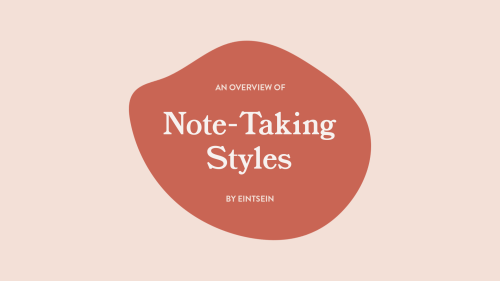

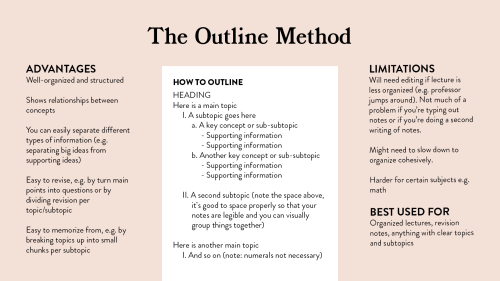
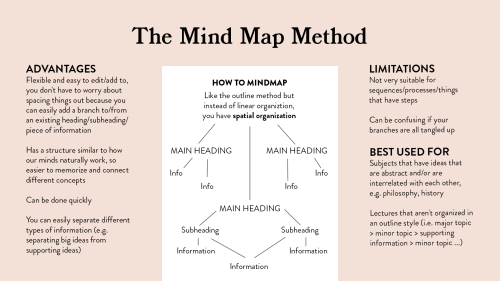

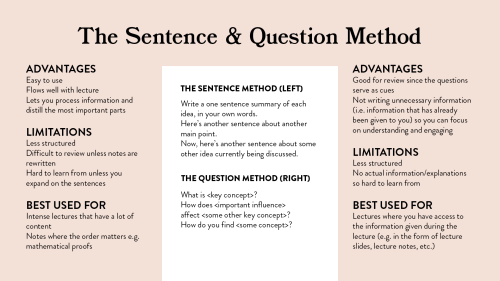


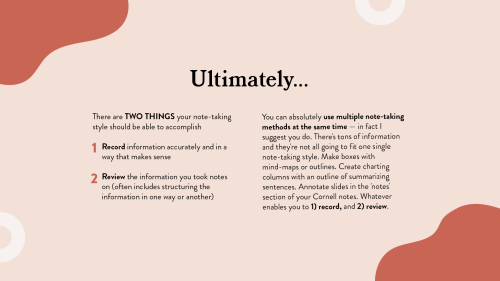
An Overview of Note-Taking Styles
Note-taking is one of the most essential skills a student should master. It allows you to record and review information to be used in the future. But what’s the best way to do so? Here’s an overview of note-taking styles that can help you maximize your learning!
-
 markusfellinger liked this · 3 months ago
markusfellinger liked this · 3 months ago -
 comic-lover reblogged this · 1 year ago
comic-lover reblogged this · 1 year ago -
 chrisnunrustnorth liked this · 1 year ago
chrisnunrustnorth liked this · 1 year ago -
 anicefishoutofthewater liked this · 2 years ago
anicefishoutofthewater liked this · 2 years ago -
 tedxman reblogged this · 3 years ago
tedxman reblogged this · 3 years ago -
 tedxman liked this · 3 years ago
tedxman liked this · 3 years ago -
 theacecase7 liked this · 3 years ago
theacecase7 liked this · 3 years ago -
 pensivechickennugget reblogged this · 4 years ago
pensivechickennugget reblogged this · 4 years ago -
 futuristiccrusadetree-blog1 liked this · 4 years ago
futuristiccrusadetree-blog1 liked this · 4 years ago -
 fukuromates liked this · 4 years ago
fukuromates liked this · 4 years ago -
 thatyellowblurb liked this · 4 years ago
thatyellowblurb liked this · 4 years ago -
 wukandaforever reblogged this · 4 years ago
wukandaforever reblogged this · 4 years ago -
 our-cosy-library liked this · 4 years ago
our-cosy-library liked this · 4 years ago -
 tech-bartender liked this · 4 years ago
tech-bartender liked this · 4 years ago -
 cartoonscientistt liked this · 4 years ago
cartoonscientistt liked this · 4 years ago -
 thelonersstuff liked this · 4 years ago
thelonersstuff liked this · 4 years ago -
 illuminatiblog liked this · 4 years ago
illuminatiblog liked this · 4 years ago -
 cyberpunktragicchick liked this · 4 years ago
cyberpunktragicchick liked this · 4 years ago -
 your-dilemma liked this · 4 years ago
your-dilemma liked this · 4 years ago -
 in-pursuit-of-virtue-ethics liked this · 4 years ago
in-pursuit-of-virtue-ethics liked this · 4 years ago -
 johanthefriskiestofbits liked this · 4 years ago
johanthefriskiestofbits liked this · 4 years ago -
 day-knight reblogged this · 4 years ago
day-knight reblogged this · 4 years ago -
 day-knight liked this · 4 years ago
day-knight liked this · 4 years ago -
 spaceismyfavouriteplace liked this · 4 years ago
spaceismyfavouriteplace liked this · 4 years ago -
 insectiile liked this · 5 years ago
insectiile liked this · 5 years ago -
 cybernetics-cyberspace reblogged this · 5 years ago
cybernetics-cyberspace reblogged this · 5 years ago -
 cybernetics-cyberspace liked this · 5 years ago
cybernetics-cyberspace liked this · 5 years ago -
 day-knight reblogged this · 5 years ago
day-knight reblogged this · 5 years ago -
 perhapsferatu liked this · 5 years ago
perhapsferatu liked this · 5 years ago -
 sannascomfortplace liked this · 5 years ago
sannascomfortplace liked this · 5 years ago -
 jonjonflores liked this · 5 years ago
jonjonflores liked this · 5 years ago -
 panisestgladio liked this · 5 years ago
panisestgladio liked this · 5 years ago -
 nofiafitri reblogged this · 5 years ago
nofiafitri reblogged this · 5 years ago -
 nofiafitri liked this · 5 years ago
nofiafitri liked this · 5 years ago -
 cel-studies-stuff reblogged this · 5 years ago
cel-studies-stuff reblogged this · 5 years ago
Hi everyone.. I'm a Researcher who interesting on the political issues. I'm doing master on International Relations and Political Science at University of Indonesia. Please don't hesitate to contact me through this. I'm also the owner of Warung Data IT...
74 posts